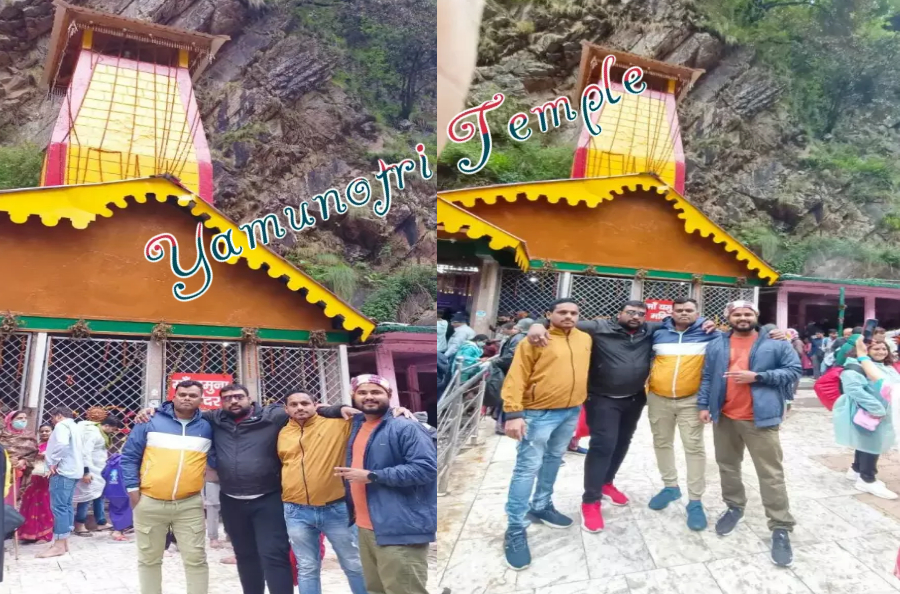Yamunotri Temple Introduction
Yamunotri, the Hindu shrine where the goddess Yamuna resides, is the place where the Yamuna River originates. It is located in the Uttarkashi District of the Garhwal Himalayas at a height of 3,293 meters (10,804 feet). It is one of the four locations included in Uttarakhand's Char Dham pilgrimage, the other three being Kedarnath, Badrinath, and Gangotri. The tour that most Hindus take is called the Char Dham Yatra because they think that seeing all of the dhams is necessary for their spiritual development. The westernmost shrine in the Garhwal Himalayas is located near Yamunotri, the source of the Yamuna River, and is positioned atop Bandar Poonch Parvat. The temple dedicated to the goddess Yamuna and the holy hot springs at Janki Chatti are Yamunotri's main draws.
The revered goddess Yamuna is known as Yami in the Vedas. She is Yama's (the deity of death) twin sister and Sun's (the goddess of life) daughter. A dip in the Yamuna's holy waters is thought to wash away all sins and guard against an early or painful death. Yamuna Devi (the goddess) holds high positions of divinity in Hindu mythology as a result of these powerful connotations.
According to legend, Lord Hanuman put out the fires on Ravana's tail in the swift waters of the Yamuna close to Banderpooch after burning his Lanka. Because of this, the peak is known as Bander's (monkey) Pooch's (tail's) or the monkey's tail. Another story claims that Asit Muni, a famous sage, lived alone in Yamunotri. The Muni used to take baths in both the Yamuna and the Ganga, but due to his old age, he was unable to travel to Gangotri. When he became aware of his issue, a Ganga stream began to run next to the Yamuna stream.
Best time to visit Yamunotri Temple
The best months to visit Yamunotri are May, June, September, and November. The temperature is pleasant at this time of year, ideal for sightseeing and temple visits. The summers are mild, whereas the winters are cold and covered in snow. Depending on the time of year, it is recommended to bring light or thick woollens.It is not advised to travel during the monsoon season owing to the possibility of landslides, floods, and other weather-related problems. Winter is not the best time to travel to Chota Char Dham because of the extremely low temperatures and the amount of snow that falls.
Places to visit near Yamunotri Temple
One of the top tourist destinations in Uttarakhand is Yamunotri. If you are visiting, be sure to see these Yamunotri tourist attractions.
Yamunotri Temple
The sacred site of Goddess Yamuna is located on a side of Banderpoonch Parbat, not far from the base of Kalind Parbat (a mountain).Yamunotri Temple, which is tucked away in the daunting Himalayas, is said to have been built in 1839 by Naresh Sudarshan Shah, the monarch of Tehri. Believers are sufficiently awed by the temple's spectacular surroundings to make it one of the Chota Char Dham pilgrimage sites. The Yamuna River shoots down from one side of the temple, which is home to a statue of the goddess Yamuna made of black marble. Ganga Devi also finds her place in a white stone along the Yamuna. Devotees can walk to Yamunotri Temple because it is close by. The starting point for the walk to Yamunotri Temple is Janki Chatti. A pony or palanquin may be rented at the base camp if you are unable to hike or trek for 6 miles. There is also a helicopter service from Dehradun to Yamunotri. The closest helipad is located at Kharsali, which is conveniently connected to Janki Chatti by road.
As winter approaches, the Yamuna shrine closes its doors on Yama Dwitiya (second day after Diwali or on Bhai Dooj). Devi's winter residence is the hamlet of Kharsali, where she travels in a palanquin and spends the whole winter season. During Akshaya Tritiya, which occurs in April or May, the goddess returns to bless Yamunotri once again. The Yamunotri shrine's closing and opening ceremonies are created by festivities, complex rituals, and vedic chanting.
Surya Kund
Many hot springs are located quite close to the Yamuna Devi temple; the Surya Kund is the most notable of these. It contains the scalding hot water when it emerges from the mountain's cracks. People cook grains and potatoes while tying them in a fabric, preferably muslin, as a devotional sacrifice to Goddess Yamuna. Here, the temperature may reach 190째F.
Divya Shila
A reddish-brown rock near the Surya Kund must be worshiped before Yamuna Maa, the main deity, may be honoured.According to the Skanda Purana, one can achieve spiritual emancipation by just touching the holy rock.
Janki Chatti
Five kilometers from Yamunotri lies Janki Chatti, which is well-known for its warm springs. Tourists can also stay in the accommodations it offers.
Kharsali
The final village in the area, one kilometer away from Janki Chatti, is Kharsali. There is a three-story Shiva temple there with carved stone walls. Another interesting feature is the elaborate woodwork.
Saptarishi Kund
It is the true source of the river and is located around 7 kilometers from Yamunotri Temple. Most of the time, ice covers this lake. The area is renowned for growing the rare Brahma lotus.
Hanuman Chatti
The trip to Dodi Tal begins in Hanuman Chatti, which is situated at the meeting point of the Hanuman Ganga and Yamuna rivers. Additionally, lodging is accessible here.
The Tapta Kunda, where pilgrims take a wash before entering the temple, and the Draupadi Kunda are two other points of interest in Yamunotri. Hindu mythology states that pilgrims who make this journey with the highest purity and dedication are freed from the cycle of life and death.
How to reach Yamunotri Temple
By Air:
Dehradun has the closest airport to Yamunotri. Fly into Jolly Grant Airport from any major Indian city.
By road:
There is no direct route to Yamunotri from the road. However, buses go from Rishikesh, Mussoorie, Uttarkashi, Gangotri, Badkot, Haridwar, and Dehradun to Hanuman Chatti. After that, you have two options: either walk the 14 miles on foot or rent some horses and palanquins.
By Rail:
Rishikesh, 200 kilometers away through Narendranagar and Haridwar, has the closest railhead.


